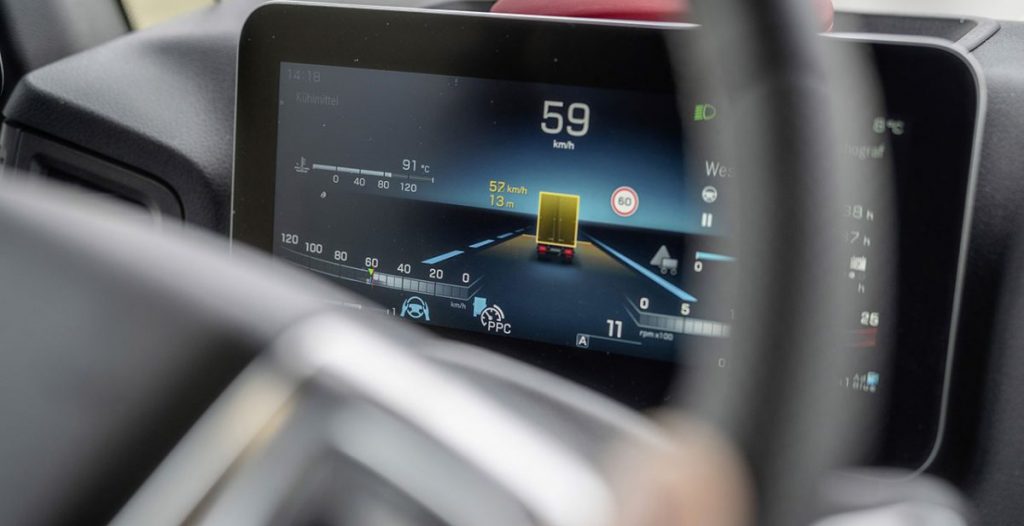Autonomous commercial vehicles require clear, consistent communication so drivers know when to relax, and when to concentrate. By Paul Woods
Countless headlines have touted the near-term promise of autonomous trucks in recent years: “Fully autonomous fleets are just around the corner”; “self-driving is coming for truckers’ jobs”; “fully autonomous ride-hailing to roll out this year.” But to date, the promise of true autonomy in commercial vehicles (CVs), laden down with a host of regulatory, liability and legal hurdles, has yet to be fulfilled.
While there is no doubt that fully autonomous commercial fleets are on the horizon, mass adoption is probably years away—despite what the dozen or so companies in the space may put forward. However, between now and that distant day, lower levels of supervised autonomy still have a significant role to play in improving the safety, comfort and performance of CVs. The question is what does that look like, and what is needed to get there?

The road to commercial fleet autonomy
Autonomy has always had massive potential when it comes to CVs—even more so than in private vehicles—especially in industries such as haulage. Fixed, long-distance routes combined with the relatively predictable road conditions on freeways, and of course, the presence of a professional driver, make it a perfect match for this technology.
Even before a full hands-off experience is legally possible, transitional autonomous levels such as Level 2 and Level 3 will have a huge impact on improving the day-to-day lives of commercial drivers. Aside from the obvious safety benefits of ADAS functions, autonomy will help reduce shipping expenses by optimising fuel and route efficiency,.
Building successful autonomous experiences
Truck drivers are highly skilled professionals, often with decades of driving experience. For autonomous technology to work in their vehicles, first and foremost these drivers must fully trust in its safety. And it is important to highlight that this is all brand new to them; the automobile has been around for well over 100 years after all. There can be no doubt in the driver’s mind that this technology will be reliable, consistent, and above all else, never behave in an unexpected manner.
Key to achieving this trust successfully lies in the minutiae of the user experience—the human factor design of how the driver and the machine interface. Based on Edenspiekermann’s experience in designing in-car user experiences with varying levels of autonomy, there are a number of key factors to success. As could reasonably be expected, when it comes to human factor design for autonomy, the devil truly is in the details.
Small visual, audio, or haptic cues orientate the driver. For example, a blinking light to indicate that the ADAS system is on, or a gentle vibration on the steering wheel that indicates the driver needs to take action
How do you know when it’s safe to take your hands off the wheel, and when do you need to immediately put them back on? Key to communicating both instances is in defining the small visual, audio, or haptic cues that orientate the driver. For example, a blinking light to indicate that the ADAS system is on, a gentle vibration on the steering wheel that indicates the driver needs to take action, or a loud audio alert to flag a serious issue. These cues must be consistently applied and reinforced to “train” the driver to know what action is—and what action is not—safe.
- Validation of the experience with extensive user testing
Validating these cues with real users is the difference between success and failure. The best automotive software teams spend months and sometimes years validating these cues through a variety of user testing, not only in the lab but also out on the road. And most importantly of all, in varying conditions.
- Consistency above all else
A laptop crashing can be a stressful experience for any user. However, that anxiety is amplified significantly when software is controlling a commercial vehicle—40 tonnes of rolling metal. While a severe software malfunction is incredibly unlikely with autonomous technology, the fear and unease of it happening is very real.
To avoid this the system must perform consistently at all times. Even the smallest of unexpected behaviours in the software—no matter how benign, such as a wrong font or button that acts incorrectly—can cause fundamental distrust in the system that is very difficult to repair. Once again, CV manufacturers are required to test, test, and then test again in every situation imaginable.

Clarity is key
The moment where driverless robo-fleets will be ubiquitous may still be some time away, but transitional autonomous technology that can have a massive impact on improving the day-to-day lives of commercial drivers—and the safety of freeways—is already here.
These first steps around HMI design play a crucial role in building trust with drivers for the day when they can finally take their hands off the wheel, close their eyes, and relax.
About the author: Paul Woods is a designer, author and Chief Executive of global design agency Edenspiekermann
